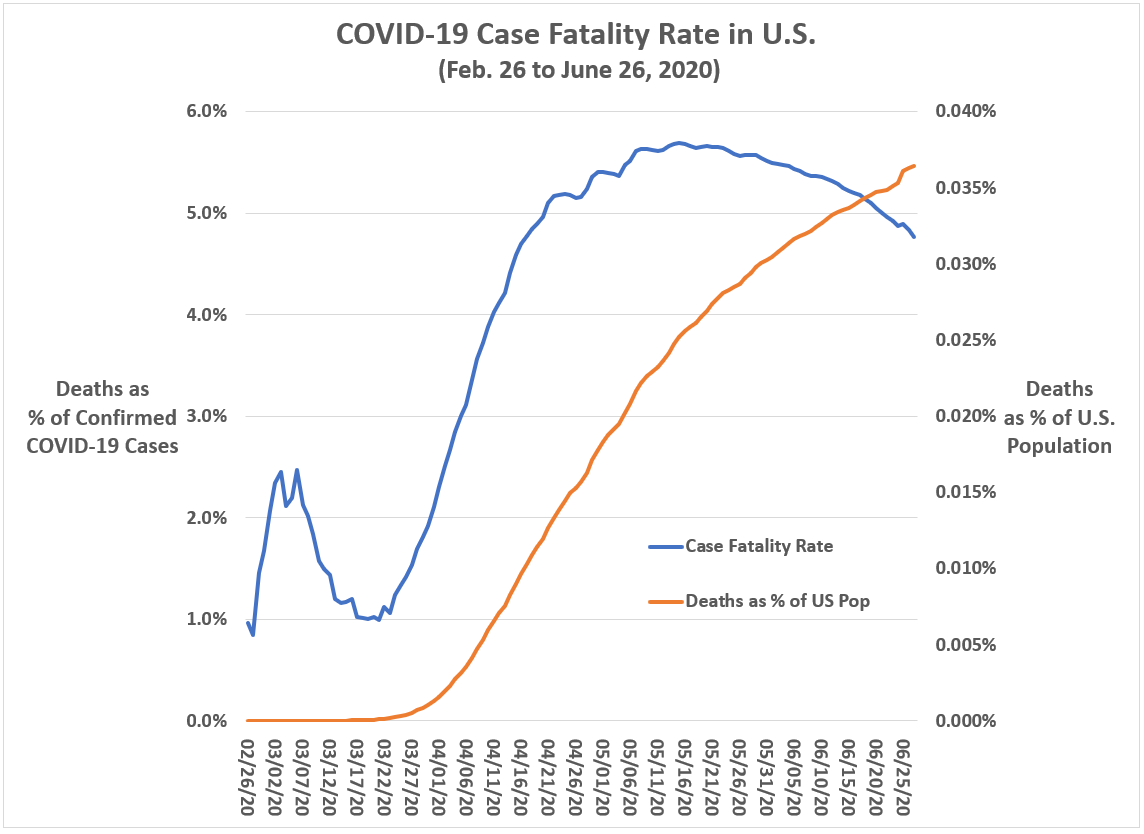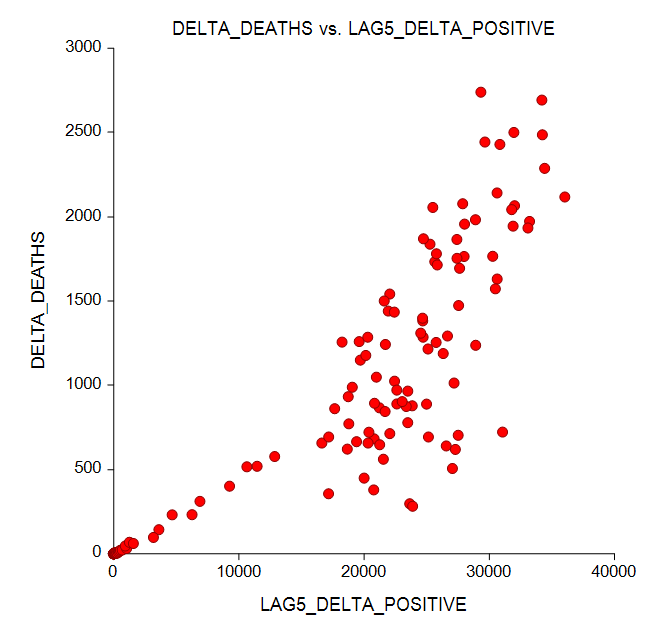By Kent R. Kroeger (Source: NuQum.com, June 30, 2020)
Yes, there is good news in the midst of the current resurgence of the coronavirus in the southern half of the U.S.
Wave 2 of this virus has been discouraging for everyone who believed this pandemic peaked in mid-April in the U.S.
It hasn’t peaked.
But, in the midst of this, there is some positive news not being widely reported: Case fatality rates in the U.S. (i.e., the ratio of coronavirus-related deaths to the number of confirmed cases) have been in decline since mid-May.
Figure 1: Cumulative COVID-19 Case fatality rate in the U.S. over time

The cause of this decline is disputable.
Here are just a few theories as to why this decline is occurring:
(1) It could be a function of increased testing. With more consistent testing nationwide, the denominator in the case fatality rate — the number of confirmed coronavirus cases — is growing more rapidly than the number who are dying. Hence, the case fatality rate is dropping over time.
(2) As time progresses, medical professionals are learning more about how to minimize the lethality of the coronavirus.
“It really does appear that doctors have gotten better at treating the disease,” summarized Salt Lake Tribune’s Andy Larsen in his investigative report on the coronavirus’ declining case fatality rate. “It is better to be a coronavirus patient in June than it was in March.”
(3) Has the coronavirus become less lethal? Virologists don’t seem to be on the side of this argument, but it remains possible that the coronavirus spreading at present through the lower half of the U.S. is not as dangerous as the one that passed through the northeast U.S. in March and April.
While epidemiologists know that viruses can mutate, the contention that the coronavirus (SARS-CoV-2) has already mutated at least once during this pandemic has elicited some healthy skepticism from Dr. Nathan Grubaugh, an epidemiologist at the Yale School of Public Health, and Dr. Richard Neher, a biologist and physicist at the University of Basel in Switzerland.
The reported mutation of SARS-CoV-2 “is most likely a statistical artifact,” says Neher. And to determine if SAR-CoV-2 has mutated will require “a nontrivial amount of effort and sometimes takes years to complete,” according to Grubuagh.
As of now, the evidence appears to support Cause #1 (increased testing) and Cause #2 (improved treatments) as the most likely explanations for the dropping U.S. case fatality rate.
The drug remdesivir in particular has shown its utility in mitigating the effects of the coronavirus in infected patients, even as many in the medical community do not view this drug as the ultimate treatment.
Gilead Sciences, the private sector pharmaceutical company responsible for producing the drug, is showing confidence in the antiviral drug’s future by setting its market price at $3,120 (per treatment) for U.S. patients under private insurance and at $2,340 for patients under Medicaid.
Epidemiologists also warn that recent declines in case fatality rates could reverse as deaths are a lagging indicator of the virus’ spread.
A Poisson regression model for daily coronavirus deaths (DELTA_DEATHS) using lagged values of new daily cases (LAG5_DELTA_POSITIVE, LAG6_DELTA_POSITIVE) found that a surge in new cases on Day 1 is followed by a surge in deaths five to six days later (see Figures 2. 3 and 4).
Figure 2: Relationship between U.S. daily coronavirus deaths (at time t) with new daily cases at t minus 5 days.

Figure 3: Relationship between U.S. daily coronavirus deaths (at time t) with new daily cases at t minus 6 days.

Figure 4: Poisson regression model of daily coronavirus deaths as a function of new daily cases at time lags of 5 and 6 days.

The Poisson regression model in Figure 4 explained approximately 84 percent of the variance in daily coronavirus deaths.
[Note: The current surge in U.S. coronavirus cases peaked on June 26th, at least for now. If the above model is useful, we should expect a surge in coronavirus deaths from July 1st to 2nd.]
Whatever the cause of the declining U.S. case fatality rates, health professionals on the pandemic’s front lines worldwide are noticing, since May, something has changed in a good way with this virus.
Alberto Zangrillo, head of San Raffaele Hospital in Milan (Italy), told the Washington Post in early June that “we cannot demonstrate that the virus has mutated, but we cannot ignore that our clinical findings have dramatically improved.”
Finally, some good news.
- K.R.K.
Send comments and questions to: kroeger98@yahoo.com
Or tweet me at: @KRobertKroeger1
